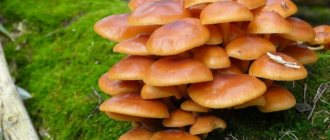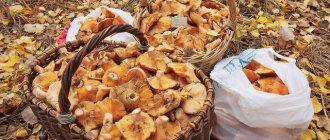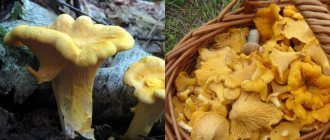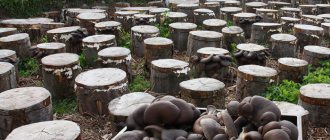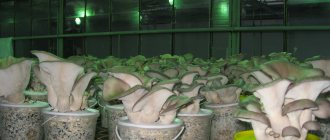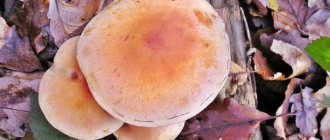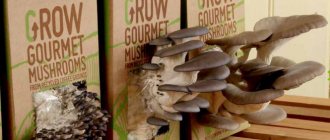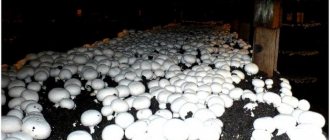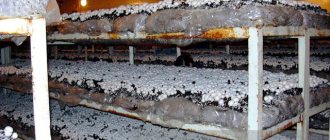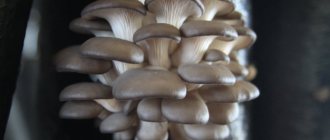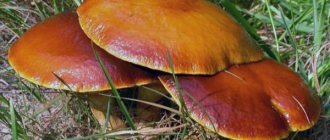Any reproduction of various mushroom cultures involves several basic cultivation methods. One of the easiest and most effective methods is the cultivation of mycelium using waste from the forest industry. The most practical is to use stumps of different types of trees on which it grows in nature. This method of cultivation is called extensive. It implies the growth process taking place in natural conditions, in the open air. In rare cases, this can be done in a basement. With this option, cash investments and material and technical base are minimal, and the yield is quite high. However, this will depend on the climatic conditions in which you are located.
Growing mushrooms on stumps at home
The extensive reproduction technique is well suited for use at home. Taking into account the peculiarities of this technology, large production scales can be achieved, but it is quite often used to satisfy only domestic needs. Plantings of several dozen families will regularly supply you and your relatives with a quality product. Industrial production volumes can be achieved through high optimization and the use of the most productive genera.
Order from us a kit for cultivating oyster mushrooms with high-yielding grain mycelium!
Cultivating mushrooms is a pleasant and rewarding activity! You can create your own high-yielding plantations with our unique oyster mushroom growing kit! It contains high-yielding grain mushroom mycelium, obtained using sterile technology, and all other components for home mushroom growing!
Planting material is produced in a specialized laboratory and meets high sowing standards. Delivery throughout Russia - by mail, cash on delivery!
Place your order by filling out the form or call us toll-free! Our managers will advise you on all your questions!
Included: 1. 5 liters of oyster mushroom grain mycelium. 2. 10 bags 350x800mm for preparing substrate blocks. 3. 10 pack. dietary supplements. 4. TGO-1 thermohygrometer for measuring air temperature and humidity. 5. Video on growing oyster mushrooms (DISC 3.5 GB). 6. Technology for growing oyster mushroom, shiitake, and champignon mycelium at home - without an autoclave.
Price: 2950 rub. 2400 rub.
What mushrooms can be grown on stumps?
If certain conditions are met, mycelium of almost all types can be grown on wood. Mushroom yields will vary significantly. In practical plant growing today, it is customary to cultivate two types of edible mushrooms: oyster mushrooms and honey mushrooms. However, it is most advisable to grow oyster mushrooms. This genus of wild plants produces the largest yield and cycles throughout the year. The technology of reproduction of different genera of this kingdom of botany on wood chocks is identical. The only difference is the natural ability of different variants of mycelium to bear fruit in a woody environment.
Types of honey mushrooms for self-cultivation
Several types of honey mushrooms grow in natural conditions, but only two of them are important for home cultivation - summer and winter (flammulina).
The winter variety of these mushrooms is attractive due to its good taste. They are consumed mainly in freshly prepared or dried form, and both caps and legs are suitable for food. The caps of winter honey mushrooms are rusty-yellow in color and can reach 9 cm in diameter. The flesh is yellowish in color and has a pleasant taste.
The natural habitat for winter mushrooms is hollows and stumps. They are usually found from October to December, but during thaws, mushrooms can be found even in February.
Winter honey mushrooms contain toxic substances (weak effect). They are present in the raw product, but are completely destroyed after 20 minutes of cooking.
Summer mushrooms are smaller in size - the diameter of the cap is up to 6 cm. They have watery pulp with a mild taste. This variety of mushrooms can be consumed even fresh.
In nature, summer honey mushrooms prefer rotten wood and grow in colonies. In mild climates, these mushrooms are found all year round.
One of the rare species is poplar honey mushrooms. They are attractive with their crispy structure and nutty flavor, but there is also a significant drawback - such mushrooms can be stored for less than a day, and when frozen, no longer than a week. Despite the name of honey mushroom, it can be grown not only on poplar, but also on maple logs.
Another rare variety of mushroom is marbled. Such mushrooms are considered a delicacy. They have a slight crunch, a nutty flavor and a sweet aroma. Raw mushrooms can be stored in the cold for 1.5 weeks.
Marble mushrooms are not soaked in water, as they absorb it and become brittle. This species is valued for its complete absence of fat and high nutrient content.
Preparing to plant mycelium
To carry out the procedure for infecting a wood piece with a seed mixture, you will need a minimum amount of materials:
- Wooden log.
- Mycelium.
- Auxiliary equipment.
For the purpose of cultivation, you can select any type of low-grade wood. But it is better to prepare those varieties on which spores prefer to grow in natural conditions. Logs should not be older than 1-2 years. It is advisable to choose options with minimal signs of destruction, since fungi very aggressively wear out the tree and your growth medium will quickly exhaust its resource.
It is best to prepare wet and fairly fresh rock. The diameter of the blanks can vary from 15 to 30 cm. The optimal option is 20-25 cm. As was said, the most cost-effective family for home and industrial production is oyster mushroom. Mycelium of this genus is sold in several forms: various containers, plastic bags.
The main nuances that you should know about are the substrate on which the mycelium is grown. The main types include: cereal grains, sawdust, bars, corn cobs. There is an opinion that the most promising option is a seeding medium grown on grains. However, no significant differences in modifications of the bases were identified. Storage of the cultivation substrate should not exceed 6-7 months. Otherwise, the prospects for spore reproduction are reduced. It is better to plant fresh, healthy material.
The main requirements for storing mycelium include temperature (+2°C) and humidity. A high-quality planting substrate is a white conglomerate that is hard to the touch. If it is significantly changed, there will be no harvest. The extensive method involves the use of mycelial gruel or water, which can be easily poured into the seedling nests. The tools with which you will prepare logs for infection can be varied. It's best to have:
- drill;
- chainsaw;
- industrial film;
- metalworker's staple gun;
- container for sterilizing logs.
Harvesting
So, when can you harvest the first harvest? If all necessary conditions are met, the first harvest can be obtained a month after planting. By this time, the mycelium should finally take root.
You can collect mushrooms several times during the season. In general, such plantations can bear fruit for three to five years, and you can reap the most abundant harvests in the second and third years. If you do not place the mycelium in a substrate with small particles, but opt for solid wood, then you will have to wait longer for the harvest, but you will be able to collect it within 5-7 years.
Of course, the amount of harvest will directly depend on the weather conditions in your region, because your “plantation” grows almost in natural conditions. In addition, the harvest can be obtained only twice a year - in spring and autumn. This is quite a profitable activity, since this growing method does not take much time and gives good results.
Small mushrooms appear after 3 weeks. In order for them to grow faster, you need to maintain a certain temperature and humidity level in the room. When the mushroom caps begin to separate well from the stems, you can begin harvesting. If you pick mushrooms with your fingers, the mycelium will be damaged, so you should use a sharp knife. Finished products can be stored in the refrigerator for 5–6 days.
If you have never done this before, before harvesting, watch the video of growing oyster mushrooms at home to get an idea of the process.
The crop will begin to grow 1–1.5 months after sowing. In just one season, the farm will bear fruit several times. If the mycelium was set up in a basement or greenhouse, mushrooms can be collected all year round. In other cases, they are collected in all seasons except winter. It is very important to start picking immediately after the mushrooms ripen, before releasing spores, as they will quickly spoil after this. To understand that the crop is ready for harvest, you need to pay attention to the stem. If its length is 4 cm or more, the harvest is ready.
Mushrooms must be removed by twisting, trying not to leave stumps, which will certainly rot or dry out. All ripe oyster mushrooms must be removed at one time, packed in perforated plastic bags. They can be stored for 1-2 weeks at a constant temperature of 5... 10°C.
So, growing oyster mushrooms on stumps is easier than it might seem. Home production does not require any expensive equipment. Almost everything you need is done and obtained independently. These mushrooms are easy to care for, fruitful and very tasty.
Mycelium cultivation technology
To sow oyster mushrooms or other genera, wooden logs are prepared, which are sawn into 30-40 cm logs, after soaking them in ordinary water for 1-2 weeks. If the preparations are freshly cut logs, then soaking them is not required. The entire infection algorithm comes down to the following basic manipulations:
- Boiling wooden blocks.
- Cutting out primary growth niches.
- Preparing the seeding medium.
- Infection.
- Wrapping the log.
To prevent the competitive growth of various microorganisms with fungi in the wood environment and to destroy antifungal substances, the method of heat treatment of the bar is used. To do this, place the logs in boiling water for 15-30 minutes.
For better infestation of spores into a wooden piece and to protect it from adverse external influences, it should be correctly placed in the log. Several methods are used for this. The first, and simplest, involves placing the mycelium on the end of the block and laying the next one on top. In this way, an artificial trunk is formed, in which each subsequent tier protects the mycelium of the previous one. Straw or sawdust is placed on the surface of the topmost one.
The second method is to put holes on the log, which serve as protection. To do this, use a conventional drill to drill several holes up to 1-15 cm in diameter to a depth of 10 cm. The method of sawing off the top layer of the block is also used. To implement it, a 4-centimeter layer of logs is cut down. The mycelium is placed on it and covered like a lid. Then they fix it with nails.
To achieve the desired consistency, the mycelium is crushed by hand and placed tightly in niches for cultivation. After which they are tightly sealed with wooden valves or paper wads for better incubation.
Micellar media constantly require a certain water content for growth. Logs must be kept at 80% moisture for growth to be successful. To preserve this environment, the stumps are wrapped in plastic film and secured with staples. For good incubation, the blanks are placed in a basement or building with minimal direct sunlight.
Further care
Growing mushrooms on stumps at home is not at all difficult; you just need to follow a few important rules for caring for mushrooms. First, watering. You need to water the soil around the stumps very carefully; excess moisture harms the mushrooms. You can use a spray bottle instead of pouring water from a watering can.
It is best to water stumps only during the dry period, because with optimal air humidity, oyster mushrooms do not require additional moisture. Secondly, take care of covering your “mushroom plantation” for the winter. Spruce branches, foliage or straw are best (you just need to cover the stumps so that they are not damaged by frost).
We invite you to familiarize yourself with the List of hormonal drugs for menopause
Mushroom care
Where to place the plantation?
The bars become overgrown in 2 – 2.5 months. After about this time, the first traces of young growth appear on them. This is a good sign. Now the logs can be installed in their permanent location. This is best done in a shaded garden. There they are buried to a depth of 10 cm. Now that your mushroom garden is ready, you need to periodically water it in very dry weather and harvest.
First fruiting
In oyster mushrooms, harvest ripening occurs in two stages. It is recommended that you familiarize yourself with the features of each of them so that you can grow delicious mushrooms in the future.
The first period of fruiting begins immediately after small gray tubercles appear in the slots of the bags. Such tubercles are the first rudiments of a crop that can later be harvested. After the tubercles appear, all bags must be moved to another room. If this is not possible, you will have to change the conditions of detention.
To maintain the fruiting process, you will have to change the temperature regime. It is allowed to lower the temperature to 12-15 degrees Celsius. In this case, humidity, on the contrary, needs to be increased. It is necessary to regularly use special humidifiers so that the air humidity is 90-95%. You will also have to install additional lighting lamps in the room. Mushrooms must be illuminated for at least eight hours daily. If they do not have enough light, they will bear fruit worse. Don't forget about ventilation. The room should be ventilated every 2-3 hours.
Successes of the Russian mushroom industry
Taking into account the traditional use of oyster mushrooms, white and other types of this plant organism in the Russian diet, mushroom cultivation is one of the most promising areas in crop production. Every year the share of Russian companies in the segment of this type of production increases significantly.
In 2015, the supply of such food products increased by 22%. The departure of foreign importers from the Russian market provides an excellent opportunity for domestic producers, whose supply volume covers only 10-15% of the Russian market. Companies involved in this segment show successful and stable economic growth. Some of the most successful mushroom growing enterprises in Russia are industrial groups in the Moscow region and the Upper Volga region. Constant production growth and high profits are shown by companies that occupy a large part of the Russian market: the Zapadny cold storage plant (), Ledovo (), Ice World (), Cold storage plant No. 1 (St. Petersburg), Elikom.
The success of these and many other farms lies in the high demand for this product and the fairly easy technological process of growing. The market in our country has a large deficit in this sector and is one of the most promising in the economy. Features of obtaining the product allow us to achieve high profitability and payback for the product. Most regions in the country are suitable for this type of business. Government programs and subsidies stimulate the development of large manufacturing companies and small private farms.
